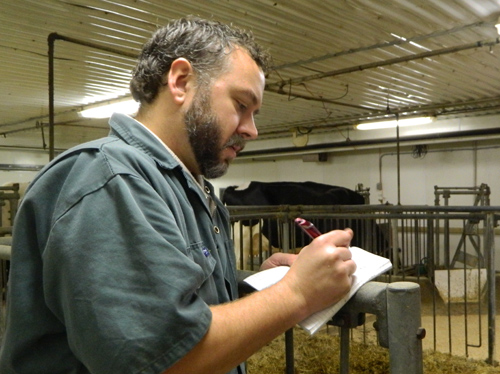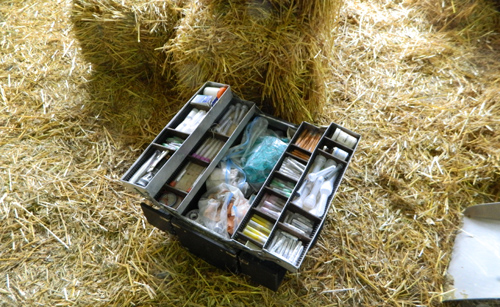
It’s 9 a.m. and Jeff Rau, wearing coveralls and rubber boots, is on his way to his first farm visit of the day. As the University’s ruminant field service veterinarian, he will tackle both scheduled visits and emergency calls for cows, goats and sheep at local farms.
“It’s a bit like being a fire fighter,” he says. “You have some scheduled activities, but a big part of the job is emergency calls.”
This first stop, though, is a planned visit – and it’s a sad one. A cow he examined and treated the week before for lameness due to tibial paralysis is not improving. Her lower leg is swollen and she stumbles across the pen. Explains Rau: “While a dog or cat might get around okay on three legs, it’s not possible for a cow because they weigh so much more.” He decides, with the owner’s approval, to euthanize her.
It’s a surprisingly peaceful process. Rau sedates her with a quick injection and then leads her near the pen’s gate, where she lies down, curling up as though ready to sleep. Another drug is administered and she’s gone almost immediately. Her body will be taken back to the Ontario Veterinary College (OVC), where students will be able to study her injury. Even in death, she’s contributing to veterinary science.
The ruminant field service has been offered since 1953 to farmers in an area between Fergus in the north, Acton in the east, Maryhill in the west and Cambridge in the south. Prof. Todd Duffield, who oversees the OVC service, says, “It’s critically important to provide hands-on teaching to fourth-year DVM students interested in either food-animal or mixed practice and to give other DVM students exposure that will help with the development of their career interests and put what they’re learning in context.”
It’s important to the farmers and their animals, too. After euthanizing the cow, Rau checks on a calf that is not eating well and is “scouring,” the farmer’s word for diarrhea. This happens often, Rau says: He’ll be called out to check one animal and is asked to take a look at another one while he’s there. It’s one reason he keeps the truck well-stocked; he never knows what equipment or medication might be needed.
The calf is lying on the floor looking rather listless but jumps up quickly when Rau arrives – a good sign. Rau uses, and teaches, a hypothetic-deductive approach to the cases he sees. Based on the symptoms he’s told about, he’ll come up with some diagnostic hypotheses – some possibilities.
“Common things occur commonly,” he says. This approach allows him to quickly and efficiently assess the situation, using the history, general inspection and physical examination of the animal to whittle down the list of possible diagnoses. He decides the calf probably has a viral infection but takes a sample of its stool for further testing.
Originally from London, Ont., Rau once wanted to be a chef. However, many of his relatives were farmers, and he grew up seeing how veterinarians contributed to the food system, so he eventually decided to attend U of G. He earned an undergraduate degree and a master’s degree in animal science and then enrolled in veterinary medicine.
After graduating with a DVM in 2007, Rau worked in a mixed-animal practice before returning to OVC to join the field service team. “My passion is the health and welfare of food animals – that’s what gets me up in the morning,” he says.
“For me, it is also the connection to the food system. That’s not just the animals; it’s also the people who raise them. Communications and client relations are a huge, huge part of the job. It is one of my goals to motivate people, students in particular, to connect with the food system. It’s something I think people in general don’t understand, but people should understand what it takes to get that meal on their plate.”
As he leaves the first farm, Rau strips off his coveralls, now stained with manure, and puts on a fresh set from the pile on the back seat of his truck. He spends several minutes scrubbing his boots with a stiff brush and washes his hands and arms as well. This is an essential step to minimize the risk of carrying disease from one farm to another and is repeated after each stop.
At the next barn, Rau walks through the rows of cows in tie stalls to see one that has not been eating well for the last day or two. When Rau examines her, he determines that she is in heat and points out that, in some cows, that can lead to disinterest in eating. The owner will breed her the next day.
The second cow he’s asked to check is also not eating well. Rau uses his stethoscope to listen intently to her right side and identifies a “ping” sound that can indicate a displaced stomach. He gives the cow some fluids and medication and says he’ll come back later in the day to see if the indications are clearer. If her stomach is displaced, surgery may be needed.
At the next farm, the cows are free to wander around the barn, and they gather curiously to watch as Rau examines a cow that has just given birth to twins, a bull and a heifer. The calves bounce exuberantly around the pen, the bull already butting his head against the legs of the humans who have invaded his territory. This cow, too, is not eating well. Rau gives her calcium and glycol to help her recover from the high energy demands of carrying twins. He’ll be back in two or three days to follow up on the cow’s progress.
The owner of this particular farm is on vacation, and his less-experienced son is managing the operation. “Because the owner is away, I know he’ll appreciate me following up,” says Rau. “That’s one of the things I try to teach the students: it’s important to demonstrate that you care. Your clients will forgive mistakes you make from lack of skill or knowledge much faster than lack of caring.”
The solid relationships Rau has forged with the local farmers are obvious; he’s greeted with teasing and jokes, plus real appreciation for his help.
[slideshow gallery_id=”4″]
After a morning of hard work with cows, Rau returns to OVC to pick up some students who will join him for the afternoon. Vet students in their final year of the food-animal stream will be scheduled to go out with Rau, but students from earlier years are also welcome to sign up for a shift. On this day, there are four students, including Rebecca Egan and Jamie Imada, who will graduate this spring.
The afternoon’s task is to ultrasound a flock of Suffolk sheep to determine which ones are pregnant. The sheep at this farm are used in breeding programs and are often shown in major livestock shows such as the Royal Winter Fair.
Doctors who deal with human patients have it easy, jokes Rau. Their patients come in one by one and willingly lie down on the table. It’s not the same story here. Sheep hate to be alone, so Rau and the students are doing the ultrasounds in a pen with at least a half-dozen other sheep. The owner pins the sheep in question firmly against a wall while Rau or a student crouches down to press the ultrasound probe against her abdomen. All eyes watch the screen on the computer perched on the shelf, hoping to see a fetal lamb and perhaps a heartbeat.
Rau is sweating. Wrestling the sheep into place and doing this exam with several other sheep – all large animals weighing close to 135 kilograms each – milling around isn’t easy, but Rau is patient with the students as they try to get the probe in the right place and locate the ewe’s uterus. Sometimes he puts his hand over the student’s hand to guide them, other times he points out anatomical landmarks on the computer screen to help them understand where to look.
This takes time; only about half the herd have been checked by the end of the afternoon, so Rau schedules a time to return and examine the others.
Earlier, he arranged for another veterinarian, Stephen LeBlanc, to check on the cow with the possible displaced stomach. The news: surgery is indicated. This is something the students want to see, so Rau heads back to the dairy farm.
By the time they arrive, LeBlanc has shaved hair from the cow’s side and poured anesthetic over the skin. Egan is given the opportunity to do the incision under LeBlanc’s direction. As she cuts through the layers, the cow becomes more restless, even kicking out at one point.
It turns out that the stomach position is normal; the symptoms and the cow’s discomfort were caused by dilatation of the caecum, which is part of the intestines. After deflating this and draining off fluids, the cow’s stomach is sutured into place to prevent future problems, followed by treatment with antibiotics. “She has an excellent prognosis,” says Rau.
He notes that even the choice of antibiotics in these cases reflects the role the animals play in the food system. For dairy cows, Rau generally recommends an antibiotic that does not require the milk to be excluded from sale for human consumption. If the cow’s milk contained an antibiotic residue that was not permitted, it would show up during testing and the farm would face a substantial fine.
It’s after 6 p.m. by the time Rau gets back to OVC, but he’s happy with his day. “I like the variety that this job offers in terms of human interactions. You’re dealing with good people all the time. It’s also rewarding to know that you’re helping people and helping animals at the same time, while teaching the next generation of vets along the way.”
